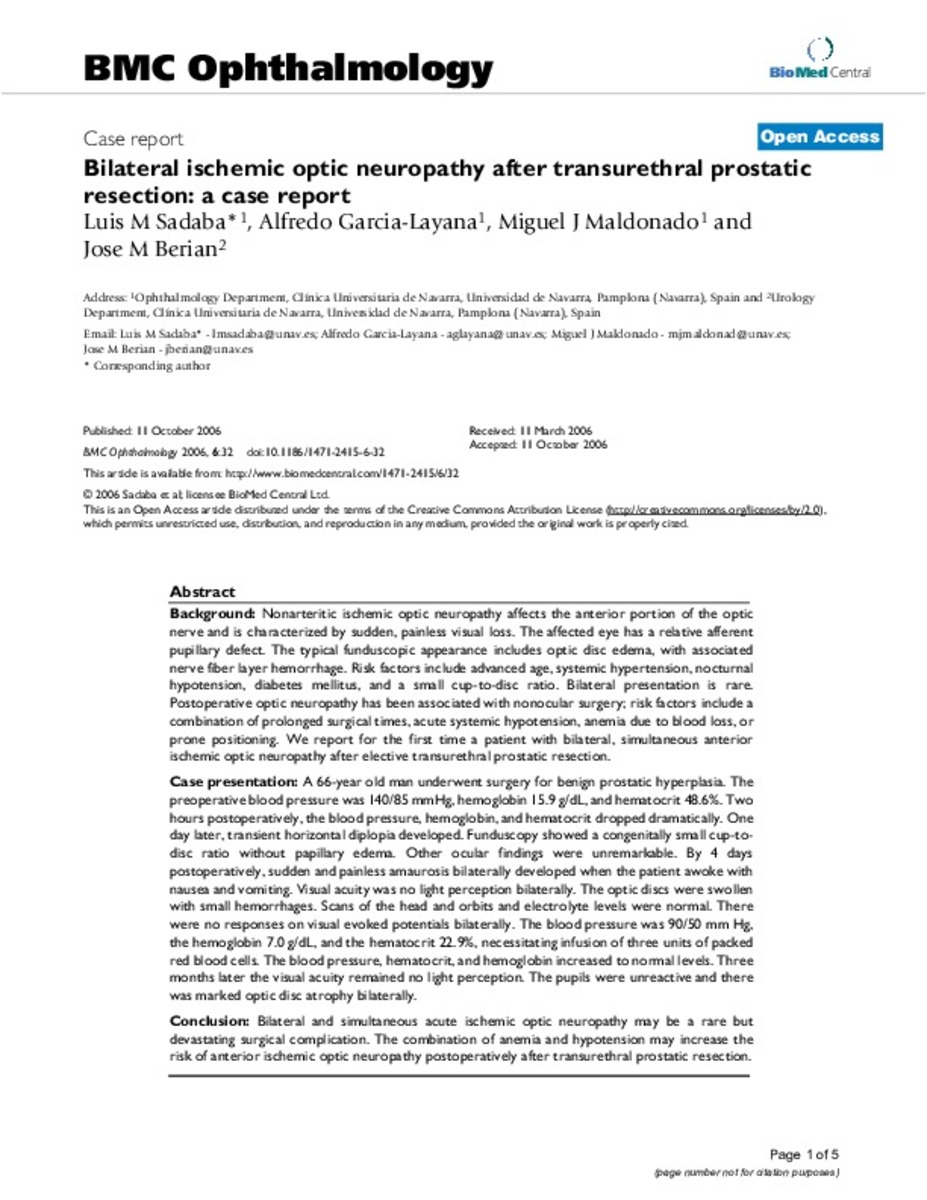Full metadata record
| DC Field | Value | Language |
|---|---|---|
| dc.creator | Sadaba-Echarri, L.M. (Luis M.) | - |
| dc.creator | Garcia-Layana, A. (Alfredo) | - |
| dc.creator | Maldonado, M.J. (Miguel J.) | - |
| dc.creator | Berian-Polo, J.M. (José María) | - |
| dc.date.accessioned | 2012-10-11T15:03:52Z | - |
| dc.date.available | 2012-10-11T15:03:52Z | - |
| dc.date.issued | 2006 | - |
| dc.identifier.citation | Sadaba LM, Garcia-Layana A, Maldonado MJ, Berian JM. Bilateral ischemic optic neuropathy after transurethral prostatic resection: a case report. BMC Ophthalmol 2006 Oct 11;6:32 | es_ES |
| dc.identifier.issn | 1471-2415 | - |
| dc.identifier.uri | https://hdl.handle.net/10171/23350 | - |
| dc.description.abstract | Background: Nonarteritic ischemic optic neuropathy affects the anterior portion of the optic nerve and is characterized by sudden, painless visual loss. The affected eye has a relative afferent pupillary defect. The typical funduscopic appearance includes optic disc edema, with associated nerve fiber layer hemorrhage. Risk factors include advanced age, systemic hypertension, nocturnal hypotension, diabetes mellitus, and a small cup-to-disc ratio. Bilateral presentation is rare. Postoperative optic neuropathy has been associated with nonocular surgery; risk factors include a combination of prolonged surgical times, acute systemic hypotension, anemia due to blood loss, or prone positioning. We report for the first time a patient with bilateral, simultaneous anterior ischemic optic neuropathy after elective transurethral prostatic resection. Case presentation: A 66-year old man underwent surgery for benign prostatic hyperplasia. The preoperative blood pressure was 140/85 mmHg, hemoglobin 15.9 g/dL, and hematocrit 48.6%. Two hours postoperatively, the blood pressure, hemoglobin, and hematocrit dropped dramatically. One day later, transient horizontal diplopia developed. Funduscopy showed a congenitally small cup-todisc ratio without papillary edema. Other ocular findings were unremarkable. By 4 days postoperatively, sudden and painless amaurosis bilaterally developed when the patient awoke with nausea and vomiting. Visual acuity was no light perception bilaterally. The optic discs were swollen with small hemorrhages. Scans of the head and orbits and electrolyte levels were normal. There were no responses on visual evoked potentials bilaterally. The blood pressure was 90/50 mm Hg, the hemoglobin 7.0 g/dL, and the hematocrit 22.9%, necessitating infusion of three units of packed red blood cells. The blood pressure, hematocrit, and hemoglobin increased to normal levels. Three months later the visual acuity remained no light perception. The pupils were unreactive and there was marked optic disc atrophy bilaterally. Conclusion: Bilateral and simultaneous acute ischemic optic neuropathy may be a rare but devastating surgical complication. The combination of anemia and hypotension may increase the risk of anterior ischemic optic neuropathy postoperatively after transurethral prostatic resection. | es_ES |
| dc.language.iso | eng | es_ES |
| dc.publisher | BioMed Central | es_ES |
| dc.rights | info:eu-repo/semantics/openAccess | es_ES |
| dc.subject | Optic Neuropathy, Ischemic/blood/etiology | es_ES |
| dc.subject | Postoperative Period | es_ES |
| dc.subject | Prostatic Hyperplasia/surgery | es_ES |
| dc.title | Bilateral ischemic optic neuropathy after transurethral prostatic resection: a case report | es_ES |
| dc.type | info:eu-repo/semantics/article | es_ES |
| dc.relation.publisherversion | http://www.biomedcentral.com/content/pdf/1471-2415-6-32.pdf | es_ES |
| dc.type.driver | info:eu-repo/semantics/article | es_ES |
Files in This Item:
Statistics and impact
Items in Dadun are protected by copyright, with all rights reserved, unless otherwise indicated.






